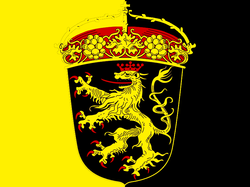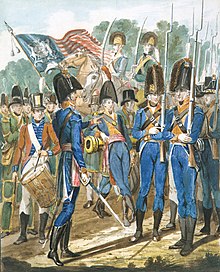 The High Dutch, descendants of the Palatines | |
| Founder | |
|---|---|
| The Holy Roman Empire, Rhenish Palatinate | |
| Regions with significant populations | |
| German Pennsylvania (Germantown, Dutchland), Ohio, Indiana | |
| Religions | |
| Roman Catholic, Lutheran, German Reformed | |
| Scriptures | |
| Latin Vulgate Bible, Luther Bible | |
| Languages | |
| Pennsylvania High German Pennsylvania Dutch English |

The Fancy Dutch (German: Hoch Deutsche), also known as the High Dutch, and historically as the Pennsylvania High Germans (German: Pennsylvanisch Hoch Deutsche), are the Pennsylvania Dutch who do not belong to Plain Dutch sects.[1][2][3][4] Unlike the Amish, the conservative Dunkards, or Old Order Mennonites, they do not wear plain clothing, and they fight in wars. Many popularly associated characteristics of Pennsylvania Dutch culture, including spielwerk, hex signs,[5] and other aspects of Pennsylvania Dutch art, music, and folklore, are derived from the Fancy Dutch. The tourism industry and mainstream media often erroneously attribute such contributions to the more conservative Plain Dutch, though they would reject these aspects of their more worldly Fancy counterparts.
For most of the 19th century, the Fancy Dutch far outnumbered the Plain groups among the Pennsylvania Dutch. But since the two World Wars and the subsequent suppression of the German language in the US, as well as socioeconomic trends generally, there was substantial pressure on the Pennsylvania Dutchmen to assimilate. All the while, the Amish population has grown, especially in recent[when?] decades.
Today most Pennsylvania Dutch speakers are Plain Dutch, whereas the Fancy Dutch have mostly assimilated into the larger Anglo-American ethnic culture of the United States and no longer present a distinct ethnic separateness. This fact contributes to the widespread misunderstanding in the 21st century whereby the term Pennsylvania Dutch is misinterpreted to be synonymous with the Plain Folk.
While Plain Dutch communities are centered on Lancaster County, Pennsylvania and Holmes County, Ohio, the Fancy Dutch or their descendants live in the countryside surrounding Reading, Allentown, York, and Lebanon. Most of their descendants are now assimilated with the larger Anglo-American culture and speak English principally and often exclusively, no longer speaking the Pennsylvania Dutch language on any daily or fluent basis.[6]
- ^ Mark G. Spencer (2015). The Bloomsbury Encyclopedia of the American Enlightenment, volume 1. Bloomsbury Publishing USA. p. 485.
- ^ P.C. Croll (1911). The Pennsylvania-German A Popular Magazine of Biography, History, Genealogy, Folklore, Literature, Etc · volume 12. p. 631.
- ^ J. Hecor St. John de Crèvecoeur (1981). Letters from an American Farmer and Sketches of Eighteenth-Century America. Penguin. p. 394.
- ^ David W. Kriebel (2007). Powwowing Among the Pennsylvania Dutch: A Traditional Medical Practice in the Modern World. Penn State Press. ISBN 978-0-271-03213-9. Retrieved August 1, 2013.
- ^ Savidge, Mariella (August 2008). "Demystifying Hex Signs, the Colorful Soul of Pennsylvania Dutch Decor". The Washington Post. Retrieved December 18, 2017.
- ^ Louden, Mark L. (2016), Pennsylvania Dutch: The Story of an American Language, Johns Hopkins University Press, ISBN 9781421428970
© MMXXIII Rich X Search. We shall prevail. All rights reserved. Rich X Search
